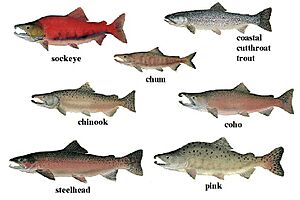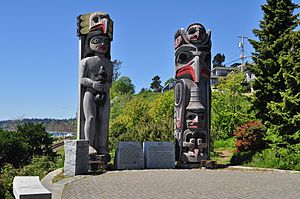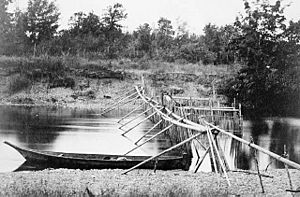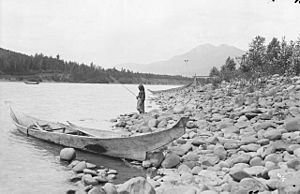Coast Salish people and salmon facts for kids
The Coast Salish people live along the Canadian Pacific coast. For thousands of years, they have relied on salmon as a main food source. Salmon is also important for trade and is a big part of their culture and identity as First Nations people.
Traditional fishing is deeply connected to Coast Salish culture. They saw salmon as "gift-bearing relatives" and treated them with great respect. This is because, in their beliefs, all living things were once people. Coast Salish people see salmon as similar to humans, but spiritually more powerful.
They use traditional fishing methods like net-fishing, stone-fishing, and weir fishing. These are simple, low-tech ways of fishing. Five types of Pacific salmon live in British Columbia waters: Sockeye, Pink, Chum, Coho, and Chinook.
Contents
Salmon: A Vital Resource
For thousands of years, long before European settlers arrived, Coast Salish people depended on salmon. It was a main food source and also used for trade. Salmon is deeply woven into their culture, who they are, and their lives as First Nations people.
The five types of Pacific salmon found in British Columbia waters are Sockeye, Pink, Chum, Coho, and Chinook. You can commonly find them in rivers like the Fraser, Skeena, Nass, Somass, Thompson, and Adams.
Salmon in the Diet
During the winter, salmon is a key food for the Coast Salish people. It provides many important nutrients. They preserve salmon in different ways. These include drying, smoking, canning, or freezing the fish.
In the Fraser Canyon, during summer, salmon is hung on racks to dry in the wind. Smoked salmon is hung inside a smokehouse for several days. Salmon can also be canned. For this, it is cut, washed, salted, and then put into cans.
Salmon can be eaten in many ways. It can be roasted, boiled, or steamed. To roast salmon, it is placed on sticks around a fire. People often eat it as a snack. Boiled and steamed salmon are cooked in special bentwood boxes or open pits.
Cultural Importance of Salmon
Traditional fishing is very important to Coast Salish culture. Salmon were seen as "gift-bearing relatives" and treated with great respect. This is because, in their traditional beliefs, all living things were once people. Coast Salish people see salmon as beings similar to humans, but spiritually more powerful.
This respect for salmon led to important cultural events. One example is the First Salmon Ceremony. This ceremony celebrated the first large sockeye salmon caught. It was a way to welcome the "king of all salmon."
The WSÁNEC (Saanich people) believed that if some salmon returned to their home rivers, their family lines would continue. This celebration could last up to ten days. Taking this time allowed many salmon to return to their rivers to lay eggs. This helped keep the salmon populations healthy.
Cultural practices also helped make sure there were enough fish. For example, the potlatch ceremony helped check if a leader's fishing methods were sustainable. Other tribes would assess their practices during these gatherings.
Community elders made decisions about when, where, how, and how much to fish. They had deep knowledge of salmon fishing. Fishing was not just a job. It was part of the community's cultural laws.
Later, new canning factories and commercial fishing industries changed things. Coast Salish fishing practices were pushed aside. They could no longer fish without special papers. Many became paid workers in the new fishing industry.
Salmon is also a cultural symbol for Coast Salish people. You can see it on Totem poles, canoes, and oars. On Totem Poles, salmon means life, plenty, good fortune, and food. It also shows reliability and the cycle of life. Even after death, salmon feed many creatures and return every year.
Ancestors believed that to have many salmon return next year, they had to be killed and prepared in certain ways. If these rules were followed, salmon would return in large numbers. This helped keep the special relationship going.
Among the Kwak'waka'wakw people, a ceremony honored salmon spirits. People wore salmon masks and danced like salmon. This journey took them to the "undersea world of the salmon people." There, they connected with their relationship and dependence on salmon. The salmon spirits would then send many salmon upstream for good harvests.
Salmon are central to many First Nations cultures. There are songs, dances, art, and stories based on salmon. Many First Nations in B.C., like the Bella Coola and Nootka, relied on salmon for food. This was true before salmon populations started to decline.
Traditional Fishing Methods
The Coast Salish fishing practices show their respect for salmon. They use traditional, low-tech methods. These include net-fishing, stone-fishing, and weir fishing. These methods are part of what is called artisanal fishing.
These techniques are used by many fishing communities worldwide. However, the Coast Salish people used them in a special way. For example, at the end of their nets, they wove a willow ring. This allowed some salmon to escape. This was done to help save salmon and out of respect for the fish.
Some communities on Vancouver Island placed willow and cedar nets. They put them at the mouth of a bay, straight out from the shore. The river's current would easily guide salmon into these nets.
Stone fishing involves building a curved line of stones. This created shallow pools. When the tide was low, salmon were easily caught from these stone traps.
Another method is weir fishing. Weirs are barriers built across rivers. The Coast Salish made them from wood for fishing. On shallow, slow-moving rivers, weirs guided fish into traps. They also directed fish towards people with other fishing tools. These fence-like structures often had parts that could be removed when not fishing. They also had complex underwater channels.
Weir fishing is sometimes debated. Some people, especially those from canning companies, argued that these barriers stopped salmon from reaching their spawning grounds. The Department of Fisheries and Oceans (DFO) considers weir fishing illegal.
However, some people argue that weir fishing might actually help save salmon. Today, some environmentalists see weirs as a way to catch fish selectively. This could help protect endangered salmon populations.
Even though these methods are called artisanal, they were not small-scale. It is thought that Coast Salish people ate between 4 million and 12 million salmon each year. This number does not include fish caught for trade or ceremonies. This large fishing system was kept healthy by carefully managing when and how much to harvest.
Fishing Rules and Changes
Many First Nations communities managed their traditional fisheries well. They used special practices that kept salmon populations healthy. They did this without the Canadian government's help.
Leaders of house groups made the rules. They decided who, when, and how people could fish. These leaders knew a lot about their families, fishing methods, and resources. They made sure fishing was fair and sustainable.
Over time, government rules and licenses started to replace these traditional ways. These new rules limited First Nations' access to fishing and salmon. This caused a lot of tension and conflict between First Nations and non-Indigenous fishermen.
- 1877: Using weirs for fishing became against the law.
- 1880: The Aboriginal Food Fishery was created. This meant First Nations could only fish for food. This was done to help commercial fishing grow.
- 1888: A rule was made that people needed licenses to fish with nets or other tools. However, it also said that "Indians shall, at all times, have liberty to fish for the purpose of providing food for themselves." But they could not sell or trade the fish.
- 1894: The Fishing Regulation Act was changed. Government officials now required Aboriginal people to get a permit to fish for food.
- 1917: A new change meant food fishing permits had the same rules as commercial fishing. This included closed seasons and limits on areas and gear.
- 1992: The Aboriginal Fisheries Strategy was launched by Fisheries and Oceans Canada (DFO). This happened after a Supreme Court ruling. The court said the Musqueam First Nation had a right to fish for food, social, and ceremonial reasons. This right came first, after conservation, over other uses of salmon. It also stressed the importance of talking with Aboriginal groups when their fishing rights might be affected.
- 1994: The Allocation Transfer Program (ATP) was created. Since this program started, 87 commercial licenses have been given to Aboriginal groups.
- 1996: The Pacific Salmon Revitalization Strategy was announced. It included a program to buy back fishing licenses from people who wanted to stop fishing.
- 1998: The Pacific Fisheries Adjustment and Restructuring Program (PFAR) was set up. This program helped commercial license holders give up their licenses. The money was used to help with better fishing methods and habitat restoration.
Fishing Licenses and Their Impact
As more non-Indigenous fishers came, more rules were put on fishing. This led to the Aboriginal Communal Fishing Licences Regulation in 1993. Before this, Coast Salish people could fish freely. After this, they had to get fishing licenses from the government. Many refused to give up their fishing traditions or buy licenses. They felt the money for licenses belonged to them.
In the 1890s, only 40 Indigenous fishers on the Fraser River had licenses. These allowed them to catch fish without working for canneries. In 1912, a policy called "bona fide white fishermen" gave priority to non-Indigenous people. Also, many Indigenous people were denied fishing licenses due to pressure from cannery owners. First Nation fishers could not get certain fishing licenses until 1924. By then, most non-Native fishers already had theirs.
The government has recognized treaty rights for Coast Salish people to fish for food. However, the Department of Fisheries and Oceans still heavily regulates it. There are rules about what gear can be used, when and where fishing can happen, and which types of fish can be caught.






